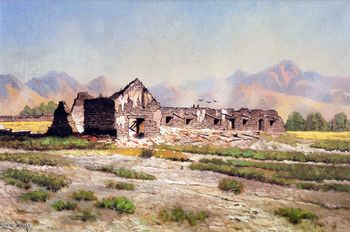Mission Nuestra Señora de la Soledad
| This article is part of a series on the Spanish missions in California  Mission Nuestra Señora de la Soledad, circa 1899.[1] | |
| HISTORY | |
|---|---|
| Location: | Soledad, California |
| Coordinates: | 36° 24′ 16.63″ N, 121° 21′ 20.9″ W |
| Name as Founded: | La Misión de María Santísima, Nuestra Señora Dolorosísima de la Soledad [2] |
| English Translation: | The Mission of Mary Most Holy, Our Most Sorrowful Lady of Solitude |
| Patron: | Blessed Virgin Mary [3] |
| Nickname(s): | "The Lonely Mission" [4] |
| Founding Date: | October 9, 1791 [5] |
| Founded By: | Father Fermín Lasuén [6] |
| Founding Order: | Thirteenth [3] |
| Military District: | Third [7] |
| Native Tribe(s): Spanish Name(s): |
Ohlone (Chalon), Esselen, Yokuts Costeño |
| Primordial Place Name(s): | Chuttusqelis [8] |
| SPIRITUAL RESULTS | |
| Baptisms: | 2,131 [9] |
| Marriages: | 648 [9] |
| Burials: | 1,705 [9] |
| Year of Neophyte Population Peak: | 1804 [10][11] |
| Neophyte Population: | 339 [10][11] |
| Neophyte Population in 1832: | 687 [10][11] |
| DISPOSITION | |
| Secularized: | 1835 [3] |
| Returned to the Church: | 1859 [3] |
| Caretaker: | Roman Catholic Diocese of Monterey |
| Current Use: | Chapel / Museum |
| Current Land Area: | 42 acres |
| California Historical Landmark: | #233 |
| Web Site: | http://www.ci.soledad.ca.us |
Mission Nuestra Señora de la Soledad is a former religious outpost established by Spanish colonists on the west coast of North America in the present-day State of California (U.S. state). Founded on October 9, 1791 by Roman Catholics of the Franciscan Order, the settlement was the thirteenth in the twenty-one mission Alta California chain. Named after the Blessed Virgin Mary, Soledad is designated as a California Historical Landmark and today serves as both a museum and a chapel within the Roman Catholic Diocese of Monterey.
History
Mission Period (1769 – 1833)
The Ohlone were converted and brought to live at the Mission, followed by the Esselen and the Yokuts. Governor José Joaquín de Arrillaga was buried in the chapel after he died on July 24, 1814 during a visit to the Mission. Though prosperous in its early years, the Mission declined after 1825. Nevertheless, Father Vicente Francisco de Sarría stayed on in poverty to serve the Indians until his death in 1835, when the Mission was secularized. This was an attempt by the Mexican government to turn the California missions over to the Indians on whose lands the missions had been established.
Rancho Period (1834 – 1849)
California Statehood (1850 – 1900)
President James Buchanan signed a proclamation on November 19, 1859 that restored ownership of the Mission proper to the Roman Catholic Church.[12] The Mission lands were subsequently "regranted" to the Bishop of Monterey. For over a century after secularization the Mission sat crumbling in the wind and rain.
20th century and beyond (1901 – present)
In 1954, when restoration was begun, only piles of adobe dirt and a few wall sections from the cuadrángulo (quadrangle) remained. The chapel was reconstructed and dedicated under the auspices of the Native Daughters of the Golden West on October 9, 1955. The ruins of the quadrangle, cemetery, and some of the outer rooms can still be seen. Governor Arrillaga's grave was identified and given a new marker.
Notes and references
- ↑ (PD) Painting: Edwin Deakin
- ↑ Leffingwell, p. 109
- ↑ Jump up to: 3.0 3.1 3.2 3.3 Krell, p. 224
- ↑ Ruscin, p. 111
- ↑ Yenne, p. 120
- ↑ Ruscin, p. 196
- ↑ Forbes, p. 202
- ↑ Ruscin, p. 195
- ↑ Jump up to: 9.0 9.1 9.2 Krell, p. 315: as of December 31, 1832; information adapted from Engelhardt's Missions and Missionaries of California.
- ↑ Jump up to: 10.0 10.1 10.2 Krell, p. 315: Information adapted from Engelhardt's Missions and Missionaries of California.
- ↑ Jump up to: 11.0 11.1 11.2 Engelhardt 1920, pp. 300-301
- ↑ Leffingwell, p. 111